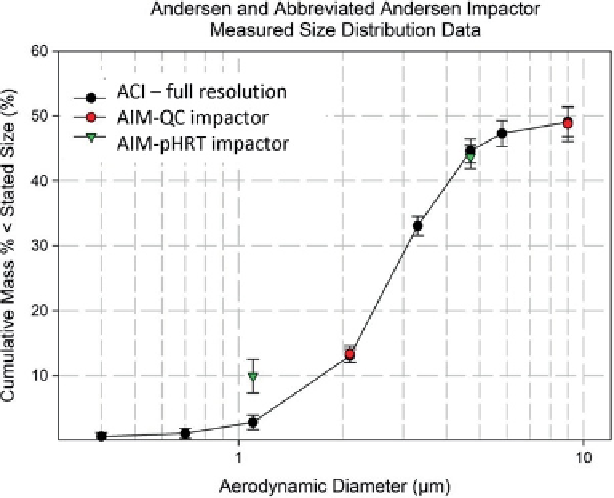Biomedical Engineering Reference
In-Depth Information
Fig. 10.12
Comparative measures of impactor-sized subfractions by AIM-QC and AIM-pHRT
abbreviated systems with ACI (original AIM-pHRT data set) (
From
[
26
]—
used with permission
)
This observation prompted a follow-on investigation to eliminate the cause of the
bias [
27
]. Microscopic inspection of the coated surface below the second stage (cut-
off diameter 1.1
m) revealed depressions in the coating directly beneath the noz-
zles, where impaction of particles would be expected (Fig.
10.13
).
Interestingly, no other collection surfaces, in either of the abbreviated systems,
exhibited the same problem. It was concluded therefore that the relatively high
Reynolds number associated with flow through the nozzles of this lower stage
(
Re
f
= 292 at 28.3 L/min) leads to displacement of the coating surface, inhibiting its
ability to trap particles effectively. Particle bounce is therefore relatively high, re-
entrainment carrying over material that should be efficiently collected into the
EPM.
This problem was successfully resolved by floating a filter coated in surfactant on
top of the collection plate (Fig.
10.14
) that provided a surface that was both energy
absorbent but at the same time resisted relocation by the incoming flow (Fig.
10.15
).
This unexpected outcome adds weight to the argument for a very careful consider-
ation of particle bounce for all abbreviated systems, regardless of OIP class.
Rather surprisingly, increased precision, one of the potential benefits initially
claimed for AIM systems by virtue of eliminating variability arising from stages
that collected API close to the lower limit of detection, was not observed with either
abbreviated system. In explanation, it was hypothesized that precision gains
achieved by eliminating the analysis of material from stages where little sample
collects are offset by other factors, possibly related to the flow of aerosol in the
μ

Search WWH ::

Custom Search